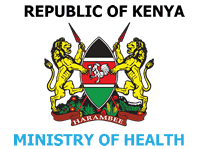
Health Burden of Tobacco Use
in Kenya
In Kenya, about 12,000 individuals die from tobacco smoking each year.
In 2022, 46% of 2000 Kenyan patients undergoing treatment for chronic respiratory disease, cardiovascular disease, diabetes mellitus, malignant cancers and tuberculosis, had a history of tobacco use.
For every $1 earned from the tobacco industry, the Kenyan economy loses $2.2 – 3.
In 2014, 11% of the Kenyan population aged 15 years and above (2.5 million people) used tobacco products (GATS, 2014). Tobacco smoking is a risk factor for numerous diseases, including chronic respiratory diseases, cardiovascular diseases, various cancers, and diabetes. Tobacco use results in disability and death and imposes significant economic costs on Kenya’s health system and economy.
This page presents data collected and analyzed in 2022 by the Tobacco Control Data Initiative (TCDI) on the morbidity (state of being symptomatic for a disease)
and mortality (number of deaths caused by a health event) from tobacco use in Kenya and the economic cost thereof. The data on morbidity and economic costs was collected from 2,032 patients aged 18 years and above at 4 major national referral hospitals in Kenya all suffering from 10 tobacco-related illnesses.The data on mortality was collected from the Civil Registration and Vital Statistics Unit within the Kenyan Ministry of Health. The data set, codebook and questionnaire are available for download on the Data and Methods page. Download the morbidity manuscript here.
In Kenya, NCDs account for more than 50% of in-patient hospital admissions and 39% of all deaths annually. Tobacco use is a risk factor for NCDs that contributes to these hospital admissions.
Distribution of Tobacco Related Illnesses Among Patients Surveyed in Four Major Hospitals in Kenya, 2022
Source: TCDI Kenya Morbidity Study, 2022
In 2015, tobacco-related diseases were the second leading cause of diseases worldwide.
The evidence linking smoking to diabetes, rheumatoid arthritis, colorectal cancer, and ectopic pregnancy is overwhelming. Exposure to Second Smoke has also been linked to stroke Tobacco smoking is associated with 24% and 44% of disability-adjusted life years (DALYs) attributable to ischaemic heart disease (IHD) and chronic obstructive pulmonary disease (COPD), respectively.Smokers are more likely than non-smokers to develop tuberculosis. Furthermore, smoking tobacco after being diagnosed with tuberculosis is linked to worse TB outcomes. Smoking worsens TB symptoms and is linked to a higher risk of TB relapse/recurrence , is linked to poor treatment outcomes and medication adherence, drug resistant TB, increased transmission of TB and TB-related deaths.
In the TCDI study, the most common tobacco related illness was oral-pharyngeal cancer. About one in three patients who sought treatment for a TRI suffered from oral-pharyngeal cancer and one in ten patients suffered from lung cancer.
Prevalence of Tobacco Use Among Patients with TRIs in Kenya
46% of patients who had been diagnosed with a tobacco-related illness (TRI) within the past five years had a history of tobacco use.
Prevalence of Tobacco Use Among Patients with Tobacco-Related Illnesses, 2022
Source: TCDI Kenya Morbidity Study, 2022
The TCDI study sought to ascertain the previous and present use of tobacco products among patients hospitalized with TRI diagnoses. Six percent of the study participants were current tobacco users, while 40% were former users. With regard to smokeless tobacco use, 1% were current users while 6% were former users. The average number of cigarettes smoked per patient was 7.7 sticks. Majority of current tobacco users (88%) were men. Comorbidities were present in 28% of the study participants, with men having more comorbidities than women (54%). Overall, 60% of the current tobacco users had tried to quit smoking in the past 12 months.
The highest proportion of tobacco users was among patients with laryngeal cancer (61%) and chronic bronchitis (60%). Furthermore, the study found that smokeless tobacco was a significant factor in the development of a number of TRIs, including chronic bronchitis, emphysema, TB, and oropharyngeal cancer.
Demographic Factors Associated with Tobacco Use Among Patients With TRIs
More men than women in Kenya suffer from tobacco-related illnesses (TRIs). According to the TCDI study, the likelihood/probability of current tobacco use depended on gender, age, employment status, and alcohol consumption. Patients older than 60 years, the employed, men, and those who have a history of consuming alcohol had higher chances of being current tobacco users.
Demographic Factors Associated with Tobacco Use
Source: TCDI Kenya Morbidity Study, 2022
Gender Differences in Morbidity From Tobacco Use
Tobacco-Related Illnesses Disaggregated by Gender, 2022
Source: TCDI Kenya Morbidity Study, 2022
In the TCDI study, more men than women had TRIs. However, incidence of CVD was higher in women (55%) than men (45%).
Between 2012 and 2021, 60,118 people aged 35 years and above in Kenya died from illnesses associated with tobacco use. Of these fatalities, 9,943 (16.5%) were attributable to cigarette smoking.
In Kenya, close to one in five deaths from Tobacco-related illnesses (TRIs) are attributable to cigarette smoking. This is higher than what has been found in countries such as Germany (17.4% for male and 9.11% for females)
and Spain at 11%.Cigarette Smoking Attributable Mortality in Kenya For Persons aged 35+ (2012-2021) by Disease
Source: TCDI Kenya Mortality Study, 2022
In 2015, tobacco smoking caused 69 deaths per 100,000 in those aged 30 years and older in Kenya. Tobacco smoking was responsible for 5% of all noncommunicable disease (NCD) fatalities in Kenya.
Cardiovascular diseases (CVDs) were the leading cause of death from tobacco use followed by cancers, respiratory diseases, and diabetes. These 4 diseases accounted for 82% of all tobacco related noncommunicable disease (NCD) deaths.However, the TCDI study indicates that as of 2022, chronic respiratory diseases at 41% had overtaken CVDs at 9% as the main cause of tobacco related deaths. This may be attributed to COVID-19 which directly and indirectly increased respiratory disease mortality outcomes.
The analysis of deaths in Kenya between 2012-2021 indicated that there was a double increase in pneumonia and influenza cases in 2020 due to COVID-19, from an average of 1,668 deaths in the previous nine years to 3,700 deaths in 2020.Malignant cancers, tuberculosis and diabetes accounted for 31%, 13% and 6% of the tobacco-related deaths respectively.
Cigarette Smoking Attributable Mortality in Kenya For Persons aged 35+ (2012-2021) by Gender
Source: TCDI Kenya Mortality Study, 2022
Out of the 9,934 deaths attributable to tobacco smoking, 8.7% were women and 91.3% were men, chiefly because men smoke more than women. The leading causes of tobacco related deaths for women between 2012 – 2021 were respiratory diseases and cancers. In the same period, tobacco use caused 87% of the trachea, lung, and bronchi cancer related deaths in men and 28.7% of the bronchitis/emphysema cases in women.
Cancer Deaths from Tobacco Use
The most prevalent cancers attributable to cigarette smoking are cancers of the respiratory system.
Cancer Related Deaths for Persons Aged 35+ Attributed to Cigarette Smoking (2012-2021)
Source: TCDI Kenya Mortality Study, 2022
According to the TCDI study, between 2012-2021 about one in three deaths of the cancers studied were attributable to smoking. 70.5% of the larynx cancer deaths were attributed to smoking followed by cancers of lung/trachea cancer (59.6%), lip/oral cavity/pharynx cancer (50.5%), and esophagus (47.6%) cancer. These findings are consistent with other studies which show that lung and esophageal cancers account for a significant percentage of mortality caused by smoking.
Global studies show that cigarette smoking is linked to 80%-90% of lung cancer deaths and accounts for 60% of deaths from lung, bronchial, and tracheal cancers.Respiratory Diseases and Tobacco Use
Between 2012 and 2021, the highest number of deaths linked to tobacco smoking were from respiratory diseases (40.5%), with men having significantly higher death rates than women.
Respiratory Disease Related Deaths Attributable to Tobacco Smoking for Persons Aged 35+ (2012-2021)
Source: TCDI Kenya Mortality Study, 2022
In the TCDI study, 4,030 people (3,617 men and 413 women) died of respiratory related diseases directly caused by smoking between 2012-2021. Pneumonia and influenza (58.5% ) were the leading cause of respiratory deaths followed by COPD (39%) and bronchitis/emphysema (2.5%). There was a double increase in pneumonia and influenza cases in 2020 due to COVID-19, rising from an average of 1,668 deaths in the previous nine years to 3,700 deaths in 2020.
This differs from the 2019 Global Burden of Disease (GBD) study,
which reported that COPD was the most significant burden of death for chronic respiratory disease. This disparity may be linked to the sub-optimal diagnosis or under-reporting of COPD in Kenya. Based on the 2019 GBD study, tobacco smoking was the leading risk factor for death among individuals with CRDs worldwide. However, the extent differed, with middle, middle-high, and high-income countries having the higher risk.The direct (treatment) and indirect (productivity) costs of tobacco smoking outweigh the financial benefits from tobacco.
Direct costs are costs associated with medical treatments for smoking-induced diseases.
This includes diagnostics, medical supplies (consumables and medicines costs), consultations (staff costs), overhead costs, capital costs, and government subsidies for the health sector.In 2021, TRIs cost the country between $544.4 and $756.2 million. Of this amount, between 27% and 48% were indirect costs while between 52% to 73% were health care related costs. These tobacco-related healthcare costs burden the country’s health systems that are already struggling to deal with numerous communicable diseases, limited numbers of medical personnel, and poor infrastructure. They also place considerable strain on individuals and families, given that health insurance coverage only stands at 26%.
Australia
In 2016, for every $0.75 gained from excise tobacco revenue $9 was lost to tobacco-related economic cost.
South Africa
In 2016, for every every $1 gained from tobacco tax revenue, $3.4 was lost to direct & indirect tobacco costs.
Uganda
In 2017, for every $1 invested in the tobacco industry, the tobacco-related economic cost was $3.
Kenya
In 2022, for every dollar accrued from tobacco tax revenue, the country lost between $2.2 and $3 to costs associated with Tobacco-Related Illnesses.
Healthcare Costs ($) by Disease Per Patient
Cost of Treating Tobacco Related Illnesses Per Case, 2022
Source: TCDI Kenya Economic Cost of Tobacco Related Illness Study, 2022
The TCDI study investigated how much it costs to treat a patient suffering from each tobacco-related illness (TRI) annually. Lung cancer had the highest cost per case, at $23,365, followed by oral-pharyngeal cancer at $7,637. The disease with the least cost per case was tuberculosis, at $1,044.However, tuberculosis costs are fully subsidized by the Kenyan government. Medicine and staff expenditures make up the bulk of these costs.
Healthcare Costs Attributable to Tobacco use by TRI
Total Healthcare Cost Attributable to Tobacco Use by Tobacco-Related Illnesses, 2022
Source: TCDI Kenya Economic Cost of Tobacco Related Illness Study, 2022
The total TRI attributable healthcare costs were $396,107,364 in 2022. The cost of care was highest for Myocardial infarctions (at $158,687,627), followed by peripheral arterial disease ($72,858,528). Oropharyngeal cancers generated the least healthcare costs, at $119,139.
Despite cancers incurring the highest treatment costs ranging from $23365 per patient for lung cancer to $6921.8 per patient for laryngeal cancer. They incur the least total healthcare costs compared to cardiovascular diseases like myocardial infarction, peripheral arterial disease, and cerebral vascular accidents (strokes). This is because most cancer cases are diagnosed at an advanced stage when treatment options are limited, leading to poor prognosis, and high fatality rates.
Productivity Losses
The productivity loss (indirect costs) due to the TRIs was between $148.6 and $360.12 million. Indirect costs primarily stem from productivity losses due to absenteeism, reduced efficiency at work and lost lives resulting from illnesses related to tobacco use.
These costs extend beyond the healthcare sector to include the effects of disease burden on caregivers, employers, industries and the economy.Indirect Costs From Tobacco Related Illnesses (Million $), 2021
Hover over the lines to view values.
Source: TCDI Kenya Economic Cost of Tobacco Related Illness Study, 2022
Emphysema had the highest productivity losses, ranging from $54.3 to $63.3 million. Tuberculosis had equally high productivity losses at between $39.49 and $53.68 million. Oropharyngeal cancer had the least productivity costs, ranging from $0.02 to $0.04 million.
Total Economic Effect of Tobacco Use
Total Tobacco Attributable TRI’s Loss to the Economy, 2021
Hover over the lines to view values.
Source: TCDI Kenya Economic Cost of Tobacco Related Illness Study, 2022
The total economic losses attributable to tobacco use from the selected TRIs ranged between $544.73 to $756.22 million. Myocardial infarction had the highest total economic losses, between $171.43 to 233.06 million, while oropharyngeal cancer had the lowest ($0.14 – $ 0.16 million). The productivity losses from tobacco use among the selected TRI accounted for between 27%-48% of the total tobacco attributable TRI’s loss to the economy. The cost benefit ratio was between 2.2 to 3, signifying that for every dollar accrued from tobacco revenue and tax we lose between $2.2 and $3 to costs associated with Tobacco related illnesses. The revenues and tax from the tobacco value chain only covered 63.8% of the estimated health expenditures caused by tobacco use.
The TCDI study is the first in Kenya that has quantified the morbidity and mortality associated with tobacco use and its economic implications. The findings are useful in informing public health policy, and the following recommendations are proposed:
1. Strengthen the implementation of the Framework Convention on Tobacco Control (FCTC). This is achieved by enforcing the provisions of the Tobacco Control Act at both the national and county level to reduce the prevalence of tobacco use.
2. Integrate robust cessation programs in health facilities, workplaces, higher education institutions, and community settings. Cessation programs should be within easy reach to the public and integrated within universal health coverage packages.
3. Gender mainstreaming in policies – Tobacco control policies and interventions should be designed with a gender perspective, given the difference in tobacco use prevalence and morbidity outcomes for men and women.
4. Conduct prospective studies with linkage to electronic records that can measure both mortality and morbidity to assess and monitor the tobacco epidemic.
5. Monitor tobacco use-attributable morbidity, mortality and economic implications of other tobacco related illnesses not covered in this study.
6. Integrate tobacco use indicators in national health surveys to supplement the data collected in periodic NCD and tobacco control surveys for proper planning.
7. Accountability of tobacco funds – Make prudent use of the funds collected through the solatium compensatory contribution paid by the tobacco industry under S 7 of the Tobacco Control Act. Funds should be used to provide cessation programs and meet health care costs related to managing TRI.
8. Progressively increase tobacco taxes in Kenya to reduce tobacco consumption and healthcare costs associated with tobacco consumption.
Secondhand smoke exposure remains a significant public health concern, affecting non-smokers across various demographics, with notable disparities observed by age group, gender and residence in Kenya.
Secondhand smoke contains more than 7,000 chemicals, 70 of which can cause cancer, and hundreds more that are toxic. Around 1.3 million non-smokers are exposed to second-hand smoke globally,
and exposure to secondhand smoke is responsible for the deaths of more than 880,000 individuals worldwide every year. About half of secondhand smoke comes from the smouldering butt of a cigarette and the other half from exhaled smoke.Non-smokers’ Exposure to Secondhand smoke at home or workplaces
Non-smoking employees often experience high levels of second-hand smoke at work. Specifically in Kenya, the workplace plays a significant role in determining the exposure of many adults to secondhand smoke, as approximately 48% of the working population worked outside their homes.
Non-smokers daily exposure rate to secondhand smoke at home and workplaces by Demographic Groups (2022)
By age group
By gender
By residence
By region
Source: TCDI compilation using TADSAS report (2022)
There is a concerning level of secondhand smoke (SHS) exposure among non-smokers, with notable disparities observed across various demographics at home and workplaces. Individuals aged 35–44 reported the highest workplace exposure (50.8%), followed closely by the 25–34 age group (49%), while older adults aged 45 and above recorded comparatively lower workplace exposure (44.4%), possibly due to senior roles in less congested work environments, which corroborates a study in the United States, where young workers reported higher exposure to secondhand smoke.
Conversely, older individuals in the 55-65 and 45-54 age brackets reported higher exposure at home, recording 10.9% and 9.7%, respectively.Gender disparities are evident, with males (52%) showing higher workplace secondhand smoke exposure than females (48%), whereas females (8.2%) experienced higher home exposure than males (4.8%). In terms of residence, urban dwellers reported a higher rate of workplace exposure, while rural dwellers faced higher home exposure compared to their urban counterparts. Regionally, exposure levels vary significantly, ranging from exceptionally high in Coast (60.2%) and Nairobi (58.8%) to relatively low in Nyanza (1.2%) and Western (3.4%).
These highlight disparity in enforcement and sociocultural factors influencing indoor smoking norms. Targeted interventions focusing on high-risk groups, residential environments, and stringent smoke-free policies across all indoor spaces are essential to protecting non-smokers from the adverse health effects of SHS exposure in Kenya.
Non-smokers’ Exposure to Secondhand smoke in Hospitality Venues
Exposure rates are more prevalent at Bars or clubs than at restaurants.
Non-smokers daily exposure rate to secondhand smoke at hospitality venues by Demographic Groups (2022)
By age group
By gender
By residence
Source: TCDI compilation using TADSAS report (2022)
Age-wise, younger individuals aged 15-24 experienced the lowest exposure rates at both restaurants and Bars or Nightclubs, while older individuals aged 55-65 experienced highest exposure rates at restaurants and Bars or Nightclubs, reporting 57.1% and 100% , respectively. In terms of gender, males are more exposed to secondhand smoke than females at restaurants and Bars or clubs. While urban dwellers experienced a higher exposure rate than their rural counterparts at restaurants and Bars or Nightclubs.
Health Effects of Exposure to Secondhand Smoke
Children are more susceptible to the effects of second-hand smoke than adults.

Adults’ exposure to secondhand smoke has immediate adverse effects on the cardiovascular system and can cause coronary heart disease and lung cancer.
Adults who live with a smoker have a 20%-30% increase in the risk of developing lung cancer.
Even brief exposure can trigger heart attacks.
Research shows that there is a 25%-30% increase in the risk of coronary heart disease with exposure to secondhand smoke.
Myths About Secondhand Smoke

Myth: Smoking out of a window or near an extractor fan will protect others in the room from secondhand smoke.
Fact: Smoke from one cigarette can linger in a room for up to two and a half hours, even with a window open.

Myth: If an inside space is ventilated after smokers have used it, there will be no health risks.
Fact: Residue from tobacco smoke can linger on surfaces, furniture, floors, and walls for several months. This is known as thirdhand smoke. Infants and young children are thought to be most at risk of this type of exposure.




